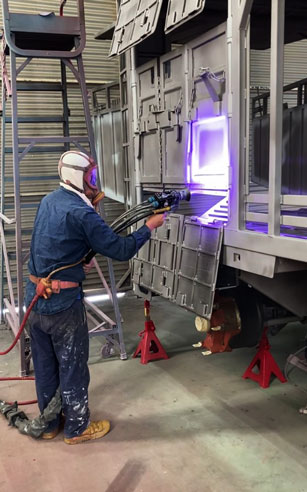

Livestock/Cattle trucks use the Arc Spray process to protect them from corrosion. The Metal Spray process has a significant advantage over Paint and Galvanising with animal transport vehicles and trailers. Not only does the surface have to be able to withstand wear (from the animal hooves etc.) that may contain erosive soil, but also the chemical effect of their urine and excrement. The use of Zinc in this application works within a pH range of 6 to 10. The urinary pH range for the cow, sheep, goat, and horse is ∼7.9 ± 0.5. For the pig, this range may extend to 6.5 ± 1.5, for cats and dogs 6.0 ± 1.0, and for humans 6.5 ± 1.5 (1). The diet of the animal is the major determinant of urinary pH levels.
The Metal Spray process has many applications that are carried out worldwide. One of its major applications is the application of anti–corrosion coatings. The material applied may be Zinc (as used in the Galvanising process), Aluminium or alloys of these materials.
The application of the coating is generally by Arc Spray (sometimes referred to as twin wire arc spray) which is a process that uses an electric arc to melt wires. The molten metal is then atomised with compressed air to create a spray stream that applies the coating onto the surface being sprayed.

 As well as providing anti–corrosion protection the coating can be applied with a coarse coating to provide anti-slip properties particularly useful on vehicle tail lifts and ramps on commercial vehicles and trailers.
As well as providing anti–corrosion protection the coating can be applied with a coarse coating to provide anti-slip properties particularly useful on vehicle tail lifts and ramps on commercial vehicles and trailers.

How Does Metal Spray Compare with Painting?
- Materials are of consistent quality and purity, no mixing required before application.
- Materials have an infinite shelf life if stored correctly.
- Fewer process steps required. This allows simpler quality control and fewer opportunities for error.
- Sprayed components require no protracted curing or drying times giving superior utilisation to floor space.
- Sprayed Zinc, Aluminium and their Alloys give effective corrosion resistance and protection immediately.
- Sprayed metals are more robust than paints and can withstand rougher usage.
- Even if the sprayed layer is damaged, the sacrificial action prevents corrosion.
- Metals can be sprayed in a wider range of climatic conditions (temperature and humidity) than paints.
- The materials used since the early 1900’s have not changed they are still in existence today, whereas numerous paint systems have been superseded many times over.
How Does Metal Spray Compare with Galvanising?
- Low heat input during spraying eliminates the risk of component distortion.
- There is no limit to the size of component to be treated.
- Components can be treated on site, meaning there are no transport or waiting issues.
- Metal spraying is used to restore corrosion protection on damaged areas of welded galvanised steel and International Standards exist covering this.
- Coating thickness can be varied from area to area to provide extra protection in critical areas.
- The Metal Spray process is not limited to Zinc as Aluminium, Steels, Bronzes etc. can also be applied for a variety of applications.
- No re-work required from galvanising dross.
- The Metal Spray coating is porous and therefore the perfect surface to accept paint (that’s if required as it is not necessary).
- No need to pre–etch etc.
As indicated above the Metal Sprayed coating is porous and therefore in this application the use of a paint sealer would be required, which as shown in AS/NZS 2312 would further enhance the life cycle of the coating.
For further information on these products or more details on the thermal spray process, contact us Metal Spray Supplies Australia (07) 3823 1004 or email using our contact form.

